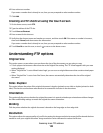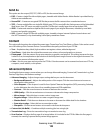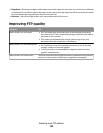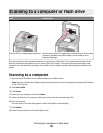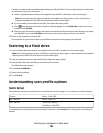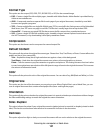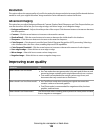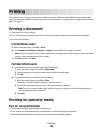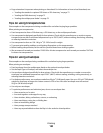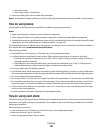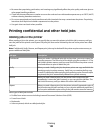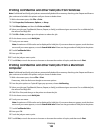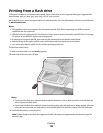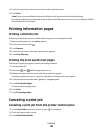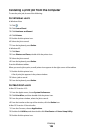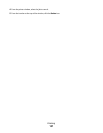• Page orientation is important when printing on letterhead. For information on how to load letterhead, see:
– “Loading the standard or optional 250-sheet or 550-sheet tray” on page 72
– “Loading the 2000-sheet tray” on page 75
– “Loading the multipurpose feeder” on page 79
Tips on using transparencies
Print samples on the transparencies being considered for use before buying large quantities.
When printing on transparencies:
• Feed transparencies from a 250-sheet tray, a 550-sheet tray, or the multipurpose feeder.
• Use transparencies designed specifically for laser printers. Check with the manufacturer or vendor to ensure
transparencies are able to withstand temperatures up to 230°C (446°F) without melting, discoloring, offsetting,
or releasing hazardous emissions.
• Use transparencies that are 138–146 g/m
2
(37–39 lb. bond) in weight.
• To prevent print quality problems, avoid getting fingerprints on the transparencies.
• Before loading transparencies, fan the stack to prevent sheets from sticking together.
• We recommend Lexmark part number 12A5010 for A4-size transparencies and Lexmark part number 70X7240
for letter-size transparencies.
Tips on using envelopes
Print samples on the envelopes being considered for use before buying large quantities.
When printing on envelopes:
• Feed envelopes from the multipurpose feeder or the optional envelope feeder.
• Set the Paper Type to Envelope, and select the envelope size.
• Use envelopes designed specifically for laser printers. Check with the manufacturer or vendor to ensure the
envelopes can withstand temperatures up to 230°C (446°F) without sealing, wrinkling, curling excessively, or
releasing hazardous emissions.
• For the best performance, use envelopes made from 90 g/m
2
(24 lb bond) paper. Use up to 105 g/m
2
(28 lb bond)
weight for envelopes as long as the cotton content is 25% or less. All-cotton envelopes must not exceed
90 g/m
2
(24 lb bond) weight.
• Use only new envelopes.
• To optimize performance and minimize jams, do not use envelopes that:
– Have excessive curl or twist
– Are stuck together or damaged in any way
– Have windows, holes, perforations, cutouts, or embossing
– Have metal clasps, string ties, or folding bars
– Have an interlocking design
– Have postage stamps attached
– Have any exposed adhesive when the flap is in the sealed or closed position
Printing
130



